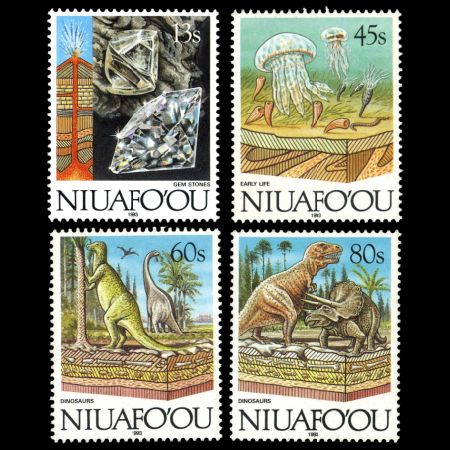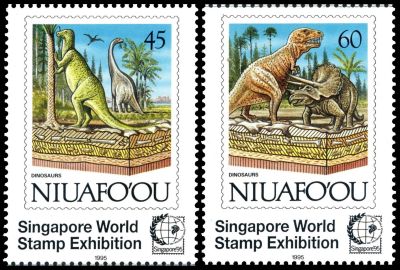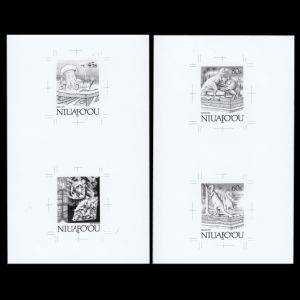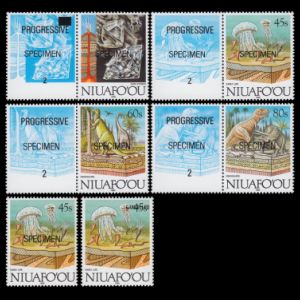Niuafoʻou (Tonga) 1993 "Evolution of the Earth (IV)"
| <prev | back to index | next> |
| Issue Date | 03.03.1993 |
| ID | Michel: 237-240, Scott: Stanley Gibbons: Yvert: UPU: N/A Category: pR |
| Designer | Mr. Ray Edge, Walsall Security Printers of London, UK |
| Stamps in set | 4 |
| Value |
13s - Formation of Gemstones 45s - Early marine life: Jellyfish, sponges, worm 60s - Herbivorous Dinosaurs: Iguanodon, Brachiosaurus and Rhamphorhynchid in background 80s - Carnivorous Dinosaurs: Triceratops and Tyrannosaurus |
| Size (width x height) | 30mm x 35mm |
| Layout | Mini-Sheet of 10 stamps, Souvenir-Sheet with 1 stamp |
| Products | FDC x2 |
| Paper | |
| Perforation | 14.5 x 14.25 |
| Print Technique | Offset, multicolor |
| Printed by | Walsall Security Printers of London, UK |
| Quantity | |
| Issuing Authority | Post office of the Goverment of Tonga |

On March 3rd of 1993, the Post office of the Government of Tonga on of behalf their Niuafo'ou Island, issued the set of 4 stamps "Evolution of the Earth (IV)".
The first three sets were issued in 1989.
The first stamp of the set shows the formation of gemstones. The second shows a scene of early marine life: Jellyfish, sponges and worms Two other stamps shows some dinosaurs. The designs from these stamps were reused for the "10 years of Niuafo'ou's Stamps" set issued 2 months later and for the "International Stamp Exhibit Singapore '95" set released in 1995.
 |
| Dinosaurs on stamps of Niuafo'ou 1995, MiNr.: 289-290, Scott: |
During the "Dinosaurs Time" the Island did not exist.
Niuafo'ou is a subaerial shield volcano formed by submarine explosive and effusive activity during the Holocene.
(The Holocene is the current geological epoch, which began approximately 11,650 years before present).
On June 11, 1993, the film Jurassic Park was released in the US.
This was the first time when the general public could see very realistic reconstructions of dinosaurs and other prehistoric reptiles.
Many Postal Authorities around the world, including Niuafo'ou, used this movie as an opportunity to issue stamps depicting dinosaurs and other prehistoric animals.
The second one shows the classic scene - the flight of Triceratops with the Tyrannosaurus-rex.
Triceratops, indeed, shared the landscape with and was most likely preyed upon by Tyrannosaurus. So far, no one has found direct evidence of a Tyrannosaurus versus Triceratops battle. A healed bite wound on a Triceratops skeleton or an injured Tyrannosaurus bone corresponding to damage that could have only been made by a horn would provide paleontologists with a sign that these dinosaurs actually fought. For many years this fight was shown on images and movies where a Triceratops run, rhino-like, into the belly of a Tyrannosaurus.
According to recent research, this defense mechanism would have not helped Triceratops out - as it would likely smash its skull and kill itself attempting it.
Most likely Triceratops would have tried to defend itself in a manner similar to modern horned animals. They would likely have shaken their heads from side to side and try to hit the aggressor.
| Two short videos with reconstructions of the fight between Triceratops and Tyrannosaurus-rex. | ||
Products
| Monochrome Proof [1] | Specimens [2] | |
 |
 |
[1] Monochrome Proofs were done on thin card and in black and white by Walsall Security Printers of London UK and were used to check the design.
The monochrome proofs were, usually, produced in amounts of 20, then sent to Tonga for the officials to check. When accepted, they were sent to stamp magazines to illustrate the upcoming new issues.
[2] The "SPECIMEN" overprint in black was the normal specimen overprint done for most sets of Tonga from 1981 to 1997.
References:
- [R1] Technical details and stamps presentation: Stamp designer Derek Miller
- [R2] Triceratops: Wikipedia, Smithsonian.
Acknowledgement:
- Many thanks to Mr. Greg Jorgensen from Australia, who sells philatelic materials from archive of Walsall Security Printers on the Internet under the nickname tonga2, for explanations about their printing process.
- Many thanks to Dr. Peter Voice from Department of Geological and Environmental Sciences, Western Michigan University, for the draft page review and his very valuable comments.
| <prev | back to index | next> |